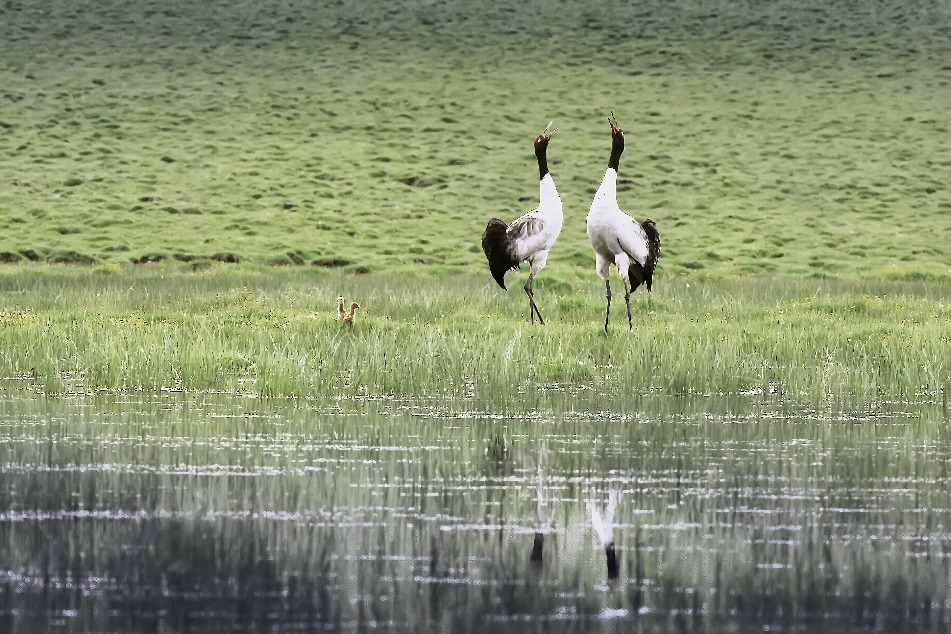For a Beautiful China


An integrated formula is needed for the Yellow River Basin to enhance watershed climate resilience
Over the past five decades, World Environment Day, which falls on June 5, has grown to become one of the largest global platforms for environmental outreach. This year, the Chinese Ministry of Ecology and Environment is celebrating it with a focus on "comprehensively promoting the development of a Beautiful China", a national-level initiative that outlines a roadmap for China's green transition.
The Yellow River Basin, a vast expanse covering nine Chinese provinces and autonomous regions and spanning nearly 800,000 square kilometers, is not just a geographical entity. It is the energy basin of China, a critical agricultural region for the entire nation, and a significant contributor to China's economic strength. Therefore, the green transition of the Yellow River Basin will not only ensure high-quality development of the region, but also serve as a model for the overall socioeconomic development of a Beautiful China in the long term.
However, pursuing high-quality development in the Yellow River Basin means overcoming numerous challenges, including water scarcity, fragile local ecosystems, and in the larger picture, climate change.
Specifically, energy production and consumption has a great impact on water resources. The Yellow River Basin is a crucial hub for energy production and consumption in China, which is predominantly reliant on coal. Shanxi and Shaanxi provinces, and Inner Mongolia and Ningxia Hui autonomous regions are key coal-producing areas in China that have facilitated the establishment of a relatively comprehensive fossil energy industry chain in the Yellow River Basin. These traditional industries often entail excessive energy consumption and have detrimental impacts on water resources and the ecological environment.
Food production also has a substantial impact on water resources. Despite the provinces within the basin making adjustments based on the water resource allocation scheme since 1987, adequate assurance of water resources for downstream grain-producing areas still needs to be improved. In addition, agricultural development has caused soil erosion and non-point source pollution to some extent. The region's ecosystem is particularly vulnerable, often leading to competition for water and land resources among the agricultural and livestock production, industrial activities and ecosystems.
Because of climate change, ensuring water, energy, food and ecological security in the Yellow River Basin will encounter new challenges. Changes in precipitation introduce greater uncertainty regarding water resource availability, while extreme weather events like floods and droughts pose significant risks to food production. Consequently, the rational allocation of water resources has become an urgent issue within the Yellow River Basin.
By promoting a green and low-carbon transition within the Yellow River Basin, we can adapt to climate change and pave the way for more sustainable and high-quality development. Strengthening the integration between management practices related to water supply, energy, food and the ecosystem will not only establish a robust foundation for development, but also ensure its stability and sustainability. This is a path that holds immense promise for the future of the Yellow River Basin.
To better exert the synergistic effect of policies, there are four potential solutions to lead the Yellow River Basin through a green transition.
First, to establish a climate-resilient mechanism for territorial space planning and implementation, with more consideration on water management and allocation scheme. By comprehensively utilizing various meteorological and water evaporation data, integrating spatial information on renewable energy, biomass energy, and energy storage projects; systematically analyzing the impact of climate change on key factors such as water resources, energy, agriculture and ecology; and establishing a master plan and utilization adjustment mechanism of territorial space interconnected by water, energy, food and ecology with climate resilience in consideration, China will be able to maximize water use efficiency while tapping into the potential of renewable energy development and enhancing ecological value.
Second, to set up pilot zones for climate-smart agriculture. To ensure food security in the Yellow River Basin and nationwide, we must establish a robust monitoring system along with an early warning response mechanism for both short-term emergencies and medium-term planning scenarios. Additionally, making disaster reduction plans explicitly tailored for different crops under extreme climatic conditions will be essential alongside strengthening agricultural producers'/operators' awareness of disaster prevention/reduction measures through technical training programs. Furthermore, coordinated management strategies encompassing water conservation practices and consumption/emission reductions within the agricultural sector should also be reinforced.
Third, to create a climate-resilient energy system and expedite the energy transition in the Yellow River Basin. The Yellow River Basin possesses abundant fossil energy resources and serves as a significant hub for renewable energies such as wind, solar and hydroelectric power in China, providing a solid foundation for energy transition. While transitioning to renewable energies, it is crucial to consider how these projects can effectively cope with extreme weather while achieving synergy between different energy sources and adapting to climate change. Furthermore, it is essential to strengthen synergies with climate risk management and optimize water resources management to ensure low-carbon development and energy security.
Fourth, to accelerate industrial low-carbon transition within the Yellow River Basin while enhancing efficient land and water resource utilization. The renewable energy potential within this region accounts for approximately 40 percent of China's overall capacity. Therefore, it is imperative to develop an industrial system centered around new energies that can generate fresh productivity within the Yellow River basin. By fostering zero-carbon fuel production and chemical industries based on green hydrogen technology and related manufacturing sectors such as new energy equipment production, consumption of new energy power systems, hydrogen storage manufacturing facilities, etc., we can promote low-carbon development throughout this area while improving industry competitiveness. While advancing renewable energies' deployment, attention must also be paid to their impact on agriculture and ecology, and measures should be taken to mitigate any adverse effects on food production or ecological balance.
The Water-Energy-Food-Ecosystem nexus in the Yellow River Basin presents significant challenges and tremendous opportunities for China to make a giant stride toward its low-carbon development goals. The basin needs to accelerate its transition while securing its role as a fundamental energy and food base. The integrated formula to build a climate-resilient Yellow River Basin will provide a solid boost to the overall development of the Beautiful China Initiative and, in the long run, contribute not only to China's carbon goals (achieving carbon peak before 2030 and carbon neutrality before 2060), but also to essential global climate targets.
The author is vice-president and chief representative of the China Representative Office of the Environmental Defense Fund. The author contributed this article to China Watch, a think tank powered by China Daily. The views do not necessarily reflect those of China Daily.
Contact the editor at editor@chinawatch.cn.


































